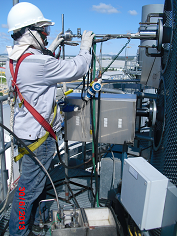Stack Emission Testing
SECOT has devoted over 10 years to conducting more than 3,000 tests for over 50 pollutants at more than 300 facilities in every major industrial category.
SECOT performs all recognized stack emission test methods covering the spectrum of gaseous and particulate emissions for virtually every category, under nearly all temperature, pressure, pollutant concentration, and gas flow conditions.
Industries utilizing SECOT stack emission testing services include petroleum, petrochemical, electric utility, pulp and paper, and manufacturing industries. SECOT has experience with the following processes :
|
|||||||||||||||||||||||||||||||||||||||||||||||||||||
l Heat Recovery Systems
l Incinerator, Kiln and Other Calciner Equipment
l Gas Turbine, Diesel, and Internal Combustion
l Fired Equipments and Boiler Control Systems
l Glass Processing
l Fired Power Boiler/Fired Process Heater
l Sulfur Recovery Unit, Thermal Oxidizer
l Combined Cycle and Cogeneration
l Natural, Forced, Induced Draft Systems
l Chemical Processing
l General Manufacturing
And Many More
|
|||||||||||||||||||||||||||||||||||||||||||||||||||||
 |
SECOT expertise also makes us especially suitable for specialized testing applications :
l High Temperature (>500oC)
l Hazardous (High Pressure, Toxic Gases etc)
l Extremely Large / Small Ducts
l Low Flow Rate
l Stratification
l Long-Term Studies
l Large Complex Testing Programs
l Control Device Evaluation ; Dedust, DeSOx,
DeNOx
|
||||||||||||||||||||||||||||||||||||||||||||||||||||
Field experience is key to completing a project on time and within budget. Therefore, SECOT has invested time and money to correct many of the problems typically associated with stack emission testing. Through the use of up-to-date and properly maintained equipment, a knowledge of testing industry practices and a mobile testing laboratory, we have eliminated many of the testing problems faced by other service providers.
SECOT offers consulting services required to prepare test schedule, coordinate stack test with operations and summarize test results for concerned agencies test report such as PCD, ONEP, MOI, IEAT etc. Test methods used are in accordance with US EPA Reference Methods specified in 40 CFR 60 Appendix A of latest version or other well recognized references of which have been approved by PCD or regulatory agencies.
|
|||||||||||||||||||||||||||||||||||||||||||||||||||||
|
|||||||||||||||||||||||||||||||||||||||||||||||||||||
